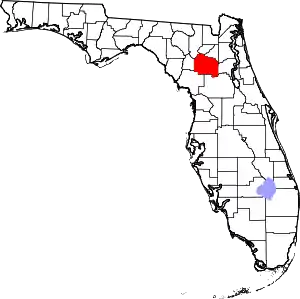Haile Plantation, Florida
Haile Plantation, an unincorporated community and New Urbanist planned development, is a 2,600-household (1,700 acre) development of regional impact southwest of the city of Gainesville, within Alachua County, Florida, United States.[1][2][3] While the Village Center provides the life of the community, most residents reside within easy walking distance in one of two associations: Haile Plantation Homeowners' Association and Haile Plantation West Homeowners' Association.
Haile Plantation, FL | |
|---|---|
Unincorporated Community | |
 Haile Village Center, 2010 | |
 Haile Plantation, FL | |
| Coordinates: 29°36′32.20″N 82°26′46.68″W | |
| Area | |
| • Total | 700 ha (1,700 acres) |
| Elevation | 26 m (85 ft) |
| Zip Code | 32608 |
| Area code(s) | 352 |
| Website | http://www.haileplantation-assoc.com/default.php http://www.hailewest.org/ |
Haile Village Center is the neighborhood center within the development. Residents and businesses in Haile Plantation use Gainesville for mailing addresses.
Haile Plantation also includes Publix Market Square, with multiple businesses centering on the Publix supermarket, including a UF Health clinic.
The development's namesake is Thomas Evans Haile, a Sea Island Cotton South Carolina planter who developed a plantation here in 1854. Enslaved African-American people lived on and worked the land. The Haile family ancestors include some who served in the American Revolutionary War. The Historic Haile Homestead, known as Kanapaha, still stands. It was featured in the 1979 movie Gal Young 'Un, based on a Marjorie Kinnan Rawlings story.[4][5]
New construction of the planned development at Haile Plantation started in the late 1970s.
On August 1, 2020, CNN published an opinion piece regarding the controversy of the Haile Planation name. The Haile Plantation West Home Owners Association formed an exploratory committee to evaluate the removal of the word "Plantation" from the name of the community.[6][7][8] On October 26, 2020 the board of the Haile Plantation West Home Owners Association voted to keep the word "Plantation" in the name of the community.[9]
References
- Beth Dunlop. "In Florida, a New Emphasis on Design". New York Times. Retrieved 2016-04-19.
- Karl Besel, Viviana Andreescu (July 19, 2013). Back to the Future: New Urbanism and the Rise of Neotraditionalism in Urban. University Press of America. pp. 77–79.
- Kohn, Margaret (2004-07-19), "Brave New Neighborhoods", Brave New Neighborhoods, Taylor & Francis, ISBN 978-0-203-49511-7, retrieved 2021-01-29
- State of Florida. "Historic Haile Homestead". State of Florida. Retrieved 2016-04-19.
- "History". Haile Homestead. Retrieved 2021-01-29.
- Alpert, Yelena Moroz. "What my Nextdoor neighbors don't get about the word 'plantation'". CNN. Retrieved 2020-08-01.
- Swirko, Cindy. "Haile Plantation residents debate name change". Gainesville Sun. Retrieved 2020-08-01.
- Brianda Villegas. "Residents call for Haile Plantation name change". WCJB. Retrieved 2020-08-01.
- "Haile Plantation West Survey Results Email Archive". Mailchimp. Leland Management. Retrieved 2021-01-12.
